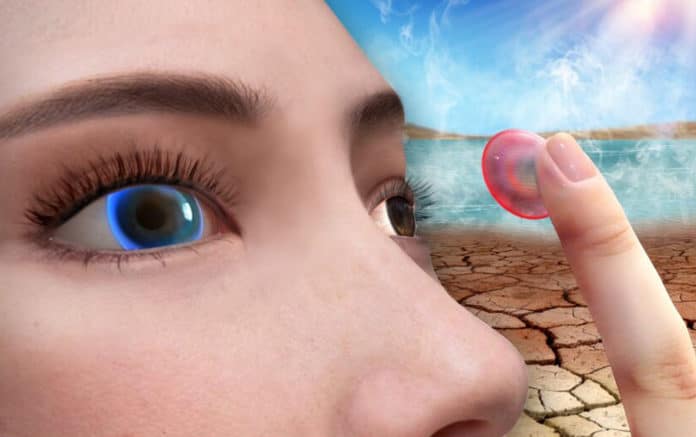Wearable electronics, coupled with wireless communications systems and monitoring technologies, are providing advances relevant to medical application development. One of these new advances is the creation of contact lenses that are capable of controlling the physiological information of the eye, the number of tears, and intraocular pressure, which allows the point-of-care (POC) diagnosis of eye diseases.
However, existing contact lens sensors usually have complex electronics and circuits whose production is complicated and requires additional instruments for signal readout.
Now, the researchers at the Shenzhen Institutes of Advanced Technology (SIAT) of the Chinese Academy of Sciences have designed a new “smart” contact lens with tunable color (ranging from red to green to blue). It can directly report the real-time changes in moisture and pressure that are critical signs for xerophthalmia and glaucoma diagnosis, respectively, by altering colors.
What’s more important is this structurally colored contact lens sensor is made solely from a biocompatible hydrogel, without the addition of any chemical pigments. The gel is made up of a polymer called poly (2-hydroxyethyl methacrylate – pHEMA for short).
The “smart” contact lens features periodic nanostructures within the pHEMA hydrogel that are sensitive to changes in moisture and pressure, leading to real-time color changes in the “smart” contact lens.
“Based on these features, the ‘smart’ contact lens was explored as a means for monitoring xerophthalmia and high intraocular pressure disease. In normal eye-simulation conditions, its color will not change over time, while its color changes from red to blue in the xerophthalmia-simulation condition in about 25 minutes,” said ZHAO Qilong, first author of the study published in the Journal of Materials Chemistry B.
In addition, when human intraocular pressure changes within the pathological range, a linear decrease in the wavelength of the reflection peak of the “smart” contact lens is observed. The hydrogel once again alters its reflective nanostructure, this time causing it to appear green.
“This study provides a novel and smart wearable device for timely and facile warning of the risks of xerophthalmia and high intraocular pressure disease. It will also inspire the design of a new generation of wearable devices with colorimetric sensing capabilities for real-time POC monitoring of various human body signs and diseases,” said Prof. DU.
With excellent biocompatibility and sensing capabilities, this “smart” contact lens holds great promise for instrument-free ophthalmic health monitoring and helps reduce the high risk of eye disease.
Journal Reference
- Yunlong Wang, Qilong Zhao and Xuemin Du. Structurally coloured contact lens sensor for point-of-care ophthalmic health monitoring. Journal of Materials Chemistry B. DOI: 10.1039/C9TB02389E
